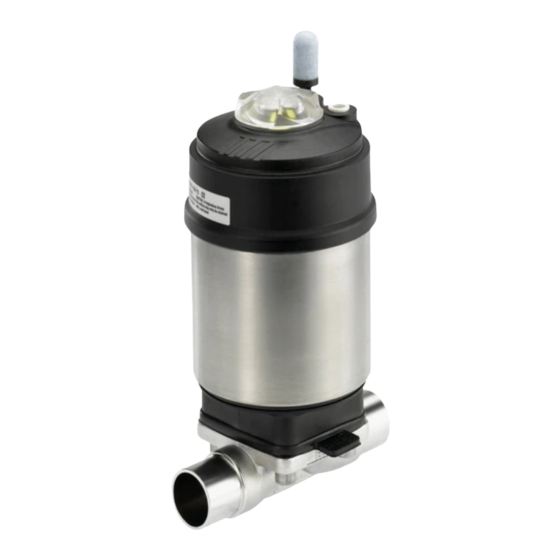
Burkert 2103 Quick Start Manual
Piston-controlled diaphragm valve
Hide thumbs
Also See for 2103:
- Operating instructions manual (142 pages) ,
- Quick start manual (53 pages) ,
- Additional instructions (12 pages)
Summary of Contents for Burkert 2103
- Page 1 Type 2103, 2104, 2105 Piston-controlled diaphragm valve Kolbengesteuertes Membranventil Vanne à membrane commandée par piston Quickstart English Deutsch Français...
- Page 2 We reserve the right to make technical changes without notice. Technische Änderungen vorbehalten. Sous réserve de modifications techniques. © Bürkert Werke GmbH & Co. KG, 2013 - 2018 Operating Instructions 1807/05_EU-ML_00810349 / Original DE...
-
Page 3: Table Of Contents
REMOVAL ................17 A detailed description of the device can be found in the operating MAINTENANCE WORK ............17 instructions for Type 2103, 2104 and 2105. 10 TRANSPORT, REMOVAL ............ 18 The operating instructions can be found on the Internet www.burkert.com... -
Page 4: Authorized Use
Type 2103, 2104, 2105 Authorized use Symbols AUTHORIZED USE DANGER! Non-authorized use of the device may be a hazard to people, nearby equipment and the environment. Warns of an immediate danger. ▶ The device is designed for the controlled flow of liquid and ▶... -
Page 5: Basic Safety Instructions
Type 2103, 2104, 2105 Basic safety instructions BASIC SAFETY INSTRUCTIONS Risk of injury from moving parts in the device! These safety instructions do not make allowance for any ▶ Do not reach into openings. • contingencies and events which may arise during the installation, ▶... -
Page 6: General Information
▶ Do not transport, install or remove heavy devices without the aid Information on the internet of a second person and using suitable auxiliary equipment. The operating instructions and data sheets for Type 2103, 2104 and 2105 can be found on the Internet at: www.burkert.com... -
Page 7: Structure And Function
Second pilot air port for CFI Valve body and air discharge connection for CFA and CFB Line connection Transparent cap with position Fig. 2: Structure and description, 2/3-way valve type 2103 indicator 5.1.3 T-valve type 2104 Actuator cover Second pilot air port for Transparent cap... -
Page 8: Technical Data
(see detailed view) Conformity Fig. 4: Structure and description type 2105 Type 2103, 2104 and 2105 conforms with the EU Directives according to the EU Declaration of Conformity. Function Standards Spring force (CFA) or pneumatic pilot pressure (CFB and CFI) gen- erates the closing force on the diaphragm pressure piece. - Page 9 Nominal Permitted pilot PN16 / CWP150 pressure pressure Control function CE identification Type 2103 A 20M PTFE VS Pilot 4,8-10bar Tamb 0°C - +60°C Pmed 10,0bar Connection orifice Tmed xxx°C - +130°C Da=26,9 s=1,6 W3ZLT XXXXXXXXXX 00175139...
- Page 10 Type 2103, 2104, 2105 Structure and function Labeling of the forged bodies Medium temperature for diaphragms: Temperature Material Remarks Batch number [°C] XX F Material EPDM (AB) -10...+130 Steam sterilization up to +140 °C / 60 min Production number / EPDM (AD) -10...+143...
-
Page 11: Installation
Type 2103, 2104, 2105 Installation INSTALLATION 6.6.1 Permitted medium pressure Permitted medium pressure depending on the medium temperature. Safety instructions Plastic body: DANGER! DN 15 - 65 Risk of injury from high pressure in the equipment or device. ▶ Before working on equipment or device, switch off the pressure and vent the lines. - Page 12 Type 2103, 2104, 2105 Installation 7.2.1 Installation position type 2103 CAUTION! • The piston-controlled diaphragm valve can be installed in any Risk of injury due heavy devices! installation position, preferably with the actuator face up. ▶ During transport or during assembly, a heavy device may fall To ensure self-drainage: and cause injury.
-
Page 13: Before Installation
Type 2103, 2104, 2105 Installation Remove the actuator from the valve 7.2.2 Installation position T-valve type 2104 body For the installation of the T-valves into circular pipelines, we rec- ommend the following installation positions: NOTICE! When media is supplied: When media is removed: Damage to the diaphragm or the seat contour. - Page 14 ▶ Before working on the system, switch off the pressure and ▶ Observe the tightening torques (see “Tab. 3”, page 15). vent or drain lines. 7.5.1 Installation of the valve body type 2103 For information on tanks and instructions on welding and 2104 observe the standard ASME VIII Division I.
- Page 15 Type 2103, 2104, 2105 Installation → Pressurize pilot air port 1 of the actuator with compressed air 2. Welding tank bottom body into the pipeline: (5,5 bar). → Weld in tank bottom body. → Actuate the diaphragm valve twice to position the diaphragm correctly.
- Page 16 Type 2103, 2104, 2105 Installation Align actuator WARNING! If the valve features a stainless steel diaphragm socket, Risk of injury from unsuitable connection hoses. the actuator can be rotated steplessly by 360 °. ▶ Use only hoses which are authorised for the indicated pres- sure and temperature range.
-
Page 17: Removal
Type 2103, 2104, 2105 Removal REMOVAL Air discharge connection CFA, CFB and second pilot air port CFI DANGER! Pilot air port Risk of injury from discharge of medium and pressure. CFA, CFB, CFI It is dangerous to remove a device which is under pressure due to the sudden release of pressure or discharge of medium. -
Page 18: Transport, Removal
Type 2103, 2104, 2105 Transport, removal Inspection intervals TRANSPORT, REMOVAL The following maintenance work is required for the diaphragm valve: NOTE! → After the first steam sterilization or when required retighten Incorrect transport and storage may damage the device. body screws crosswise. - Page 19 www.burkert.com...










Need help?
Do you have a question about the 2103 and is the answer not in the manual?
Questions and answers